The American Society of Mechanical Engineers
8 Ways 3D Printing is Helping to Fight Coronavirus
By: Mark Crawford
As the COVID-19 pandemic depletes critical medical supplies around the world, 3D printer manufacturers, as well as manufacturers with 3D printers, are converting their processes to produce these vital supplies and equipment. Members of the 3D printing community around the world are volunteering their time and resources to manufacture these life-saving supplies, which are in high demand and desperately short supply.
Below are eight ways 3D printing is being used to battle the coronavirus crisis and save lives.
1. Safety Goggles
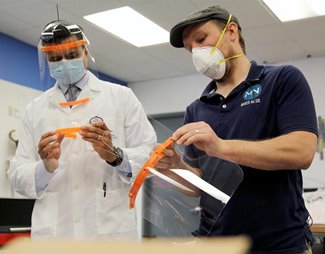
A nonprofit organization called Maker Nexus has used its 3D printers and laser cutters to produce masks for local hospitals. Photo: Maker Nexus
An unnamed Chinese manufacturer has dedicated its supply of more than 200 3D printers to mass-produce safety goggles for healthcare workers. The engineering team took about two weeks to design and test the product. More than 5,000 pairs of goggles have been 3D printed and distributed to Chinese hospitals, with the ultimate goal of producing about 10,000 pairs daily.
2. Oxygen Valves
When an Italian hospital ran out of the respiratory valves needed to connect COVID-19 patients to ventilator machines, an Italian engineering firm, Isinnova, decided to mass-produce the valves using 3D printing. After examining the valve and creating a prototype, the company collaborated with a local manufacturing firm to create 100 valves in 24 hours.
3. Nasal Swabs
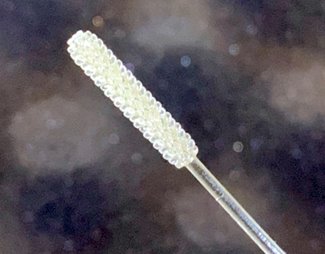
Formlabs is shipping 3D printed nasal swabs to hospitals across the country that are desperately in need of supplies for early coronavirus detection. Photo: Formlabs
Formlabs, a 3D printing technology developer and manufacturer, will use 250 printers in its Ohio factory to manufacture up to 100,000 nasal swabs for COVID-19 testing every day. Swabs will be shipped to hospitals across the country that are desperately in need of supplies for early coronavirus detection, such as Tampa General Hospital in Florida and Northwell Health in New York City. The company is also releasing the design to the public so others can also manufacture the swabs.
4. Masks and Shields
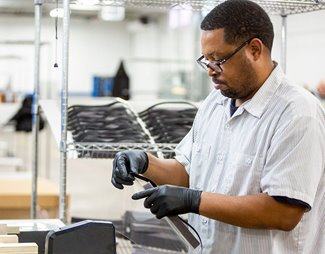
Ford is prototyping transparent face shields for medical staff and first responders. Photo: Ford
Ford is prototyping transparent face shields for medical staff and first responders, with the goal of producing more than 100,000 per week. Carbon, a 3D-printer manufacturer in Redwood City, California, has collaborated with Verily also to design face shields. The team has produced prototypes that are being tested in several San Francisco Bay Area hospitals. In Sunnyvale, California, a nonprofit organization called Maker Nexus has used its 13 3D printers and three laser cutters round the clock to produce masks for local hospitals, using the open-source Prusa 3D printed shield design from the Czech Republic. The rocket company Blue Origin is also 3D printing parts for face shields.
5. Quarantine Booths
Winsun, a 3D printing company based in China, has used its resources to 3D print 15 quarantine rooms for Xianning Central Hospital, located in the hard-hit province of Hubei. The source material for the rooms consists of crushed and ground solid urban construction waste. The quarantine booths, which have their own water and electricity supplies, are intended to relieve patient crowding and stress on the hospital’s resources.
6. Ventilators
The University of Minnesota has collaborated with Protolabs, a provider of 3D printing services, to develop key parts for a low-cost ventilator. In other ventilator news, Formlabs has successfully printed a ventilator splitter, which allows a single ventilator to support multiple patients. Prisma Health, a major healthcare system in South Carolina, has done something similar with its VESper system. This 3D-printed device allows a single ventilator to support up to four patients during times of acute equipment shortages.
7. Respirators
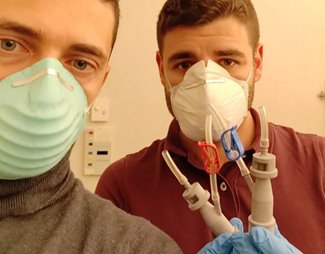
Isinnova has partnered with Sports equipment manufacturer Decathlon, which provided CAD files of its Easybreath scuba mask, to develop innovative respirators. Photo: Isinnova
Isinnova has made another contribution to the fight against COVID-19. Concerned about the potential shortage of continuous positive airway pressure masks, which can be used for sub-intensive care of patients suffering from COVID-19, an Italian physician contacted the company about possibly converting scuba masks into makeshift respirators that can then be connected to ventilators. Isinnova partnered with Sports equipment manufacturer Decathlon, which provided CAD files of its Easybreath scuba mask, to develop the innovative respirators.
8. Door Handle Attachment
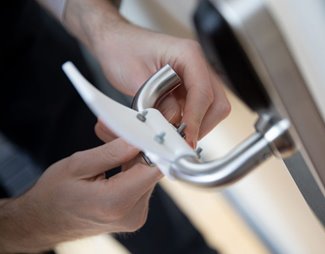
Materialise, a provider of 3D printing services, has created a 3D printed hands-free door handle attachment to reduce the possibility of catching COVID-19 via contaminated door handles. Photo: Materalise
Materialise, a provider of 3D printing services, has created a 3D printed hands-free door handle attachment to reduce the possibility of catching COVID-19 via contaminated door handles. The 3D printable add-on allows users to carry out the lever-action to open a door using their elbows. The file for the handle attachment has been made free to the public. To date, the design has been downloaded more than 30,000 times.
An Ongoing Battle
Companies continue to step up and offer their 3D printing services to make protective equipment for those who need it. For example, Airwolf 3D has volunteered its fleet of 3D printers for the manufacturing of respirator valves and custom medical components. SmileDirectClub, a teledentistry company, plans to set up a 3D printing facility to produce the medical supplies needed to fight the COVID-19 pandemic.
3D printing has already established an essential role in fighting the COVID-19 pandemic and saving lives. More manufacturers and suppliers will hopefully follow these leads and convert their production lines to make life-saving equipment.

